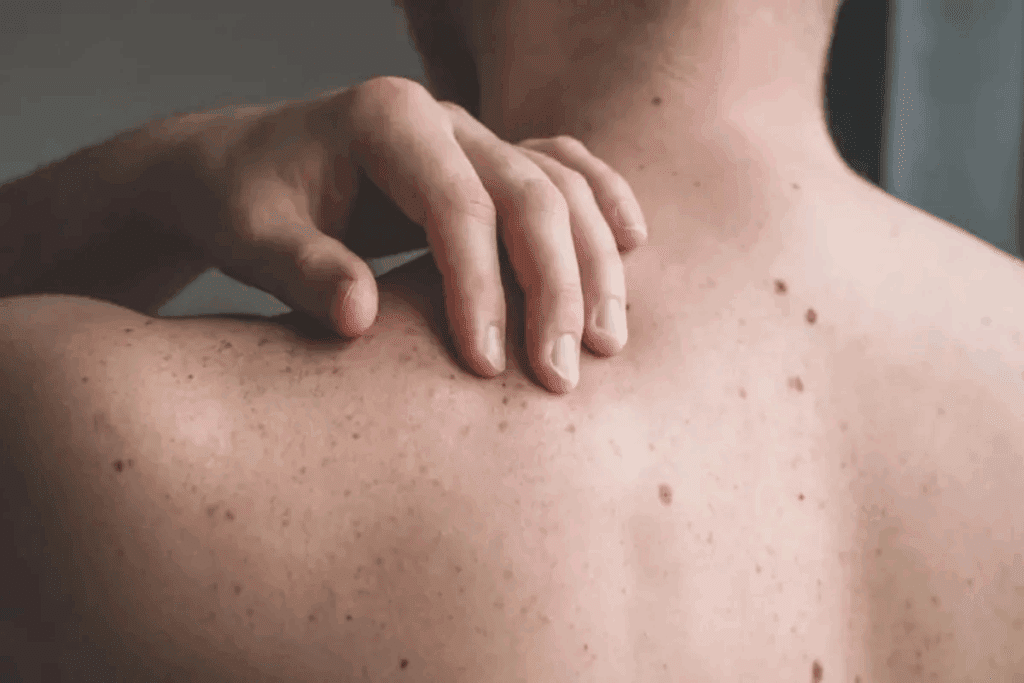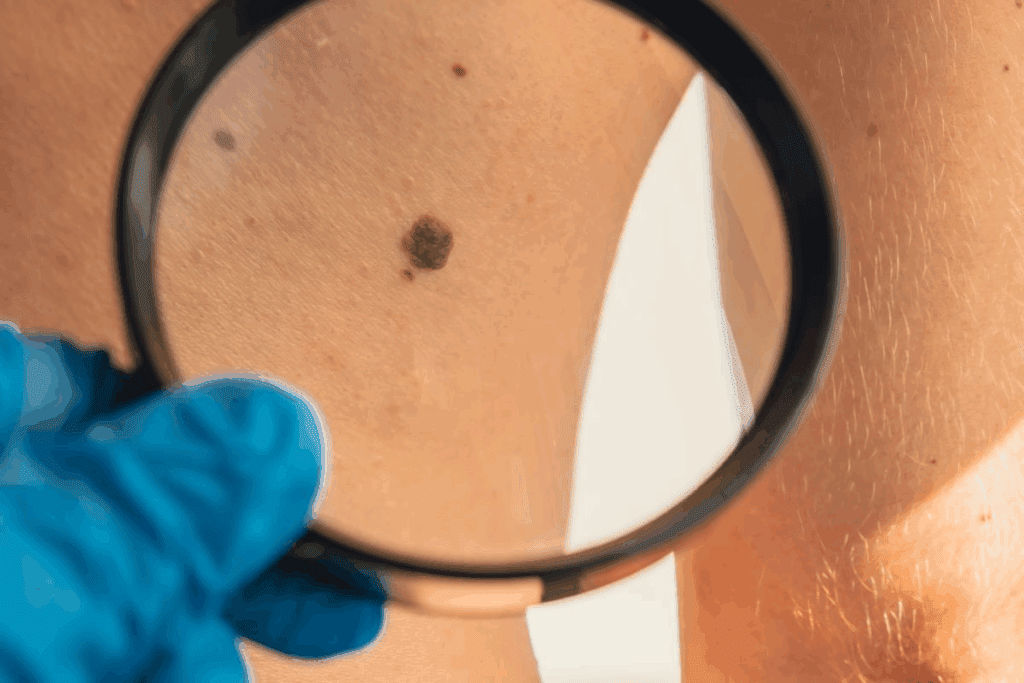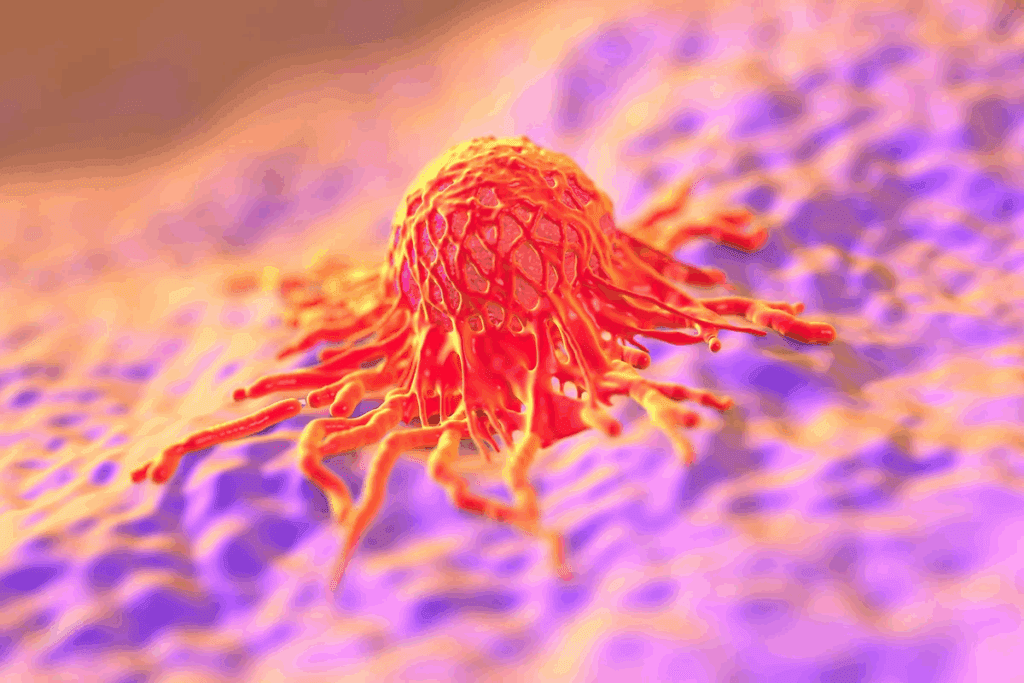Last Updated on November 27, 2025 by Ugurkan Demir

Skin cancer on the scalp is a serious health issue that needs quick attention and a doctor’s check-up. Even though the scalp gets a lot of sun, it’s often missed during skin checks. Are brown spots on scalp a concern? Learn the 7 key signs of skin cancer, including melanoma and BCC, to look for.
Early detection is key, as scalp melanomas have worse outcomes than other body parts. At Liv Hospital, we have skilled dermatologists and oncologists. They use the latest methods to find skin cancer early.
Knowing the warning signs is vital for your health. We want to teach you about the important signs of skin cancer on the scalp. This highlights the need for a doctor’s visit.

It’s important to know about skin cancer on the scalp to catch it early. The scalp gets a lot of sun, which can harm it. This makes it more likely to get skin cancer.
The scalp is at risk for skin cancer for a few reasons. Prolonged exposure to UV radiation from the sun or tanning beds can damage skin cells. This can lead to cancer.
People with fair skin, who have had sunburns before, or have a family history of skin cancer are at higher risk. The hair on the scalp can hide early signs of cancer. So, it’s key to check yourself often.
| Risk Factor | Description |
| UV Radiation Exposure | Prolonged exposure to UV rays from the sun or tanning beds |
| Fair Skin | Individuals with fair skin are more susceptible to UV damage |
| History of Sunburns | Previous sunburns increase the risk of developing skin cancer |
| Family History | A family history of skin cancer can increase an individual’s risk |
Finding skin cancer early on the scalp can greatly improve treatment chances. Spotting signs and symptoms early can save lives. We suggest regular self-checks and doctor visits, mainly for those at higher risk.
When checking yourself, look for any new growths, changes in moles, or other unusual spots. If you find anything suspicious, see a dermatologist right away.

It’s important to know about the different skin cancers that can show up on the scalp. These include basal cell carcinoma, squamous cell carcinoma, and melanoma. The scalp gets a lot of sun, making it a high-risk area for these cancers.
Basal cell carcinoma is the most common skin cancer found on the scalp. It grows slowly and doesn’t hurt. But, if not treated, it can damage the tissue around it.
Characteristics of BCC on the Scalp:
Squamous cell carcinoma is another common scalp cancer. It’s more serious than BCC and can spread. SCC looks like a firm, red bump or a scaly patch on the scalp.
Characteristics of SCC on the Scalp:
A study in the Journal of the American Academy of Dermatology found SCC often shows up in sun-exposed spots, like the scalp.
“Squamous cell carcinoma is a significant concern due to its high risk of spreading, which is a big worry for sun-exposed areas like the scalp.”
Journal of the American Academy of Dermatology
Melanoma is the most dangerous skin cancer and can appear on the scalp. It starts from cells that make skin color. Finding melanoma on the scalp can be hard because of the hair.
Characteristics of Melanoma on the Scalp:
| Type of Skin Cancer | Characteristics | Potential for Metastasis |
| Basal Cell Carcinoma (BCC) | Slow-growing, painless | Low |
| Squamous Cell Carcinoma (SCC) | More aggressive, firm red nodule or scaly patch | Moderate to High |
| Melanoma | Arises from melanocytes, challenging to detect | High |
Brown spots on the scalp are common. But, it’s important to know the difference between harmless spots and those that might be cancerous. Regular self-examination and watching for changes in moles or spots are key to early detection.
Not all brown spots on the scalp are cancerous. Many spots come from sun exposure, aging, or other reasons. But, some spots might show signs of being cancerous. It’s wise to watch for spots with unusual features.
Characteristics of potentially cancerous lesions include:
| Characteristics | Benign Lesions | Cancerous Lesions |
| Symmetry | Typically symmetrical | Often asymmetrical |
| Border | Smooth, well-defined borders | Irregular, scalloped borders |
| Color | Uniform color | Multiple colors or shades |
Effective scalp examination needs detail and a methodical approach. Use a mirror to check your scalp well, dividing it into sections for a full check.
Steps for a thorough scalp examination:
Early detection is key to treating skin cancer well. By knowing the signs and regularly checking your scalp, you can spot issues early.
When checking your scalp for skin cancer signs, look for asymmetrical growths or lesions. Asymmetry means a growth doesn’t look the same on both sides. This is a big warning sign.
Asymmetrical lesions can look different in many ways. They might be irregularly shaped or have uneven borders. A key characteristic is that one part of the lesion looks different from the other part. This could mean the growth is cancerous.
Looking at pictures is key to spotting asymmetrical lesions. Images of skin cancer lesions can help you understand what to look for. By comparing normal skin with cancerous ones, you can spot signs of skin cancer on your scalp.
It’s important to watch for changes in your scalp. If you see any unusual or asymmetrical growths, see a healthcare professional. Early detection is key to treating skin cancer well.
When checking your scalp for skin cancer, look for irregular or scalloped borders around any spots. Cancerous spots usually have uneven edges. This is different from benign growths, which have clear, defined edges.
To spot border irregularities, examine the edges of any scalp spot closely. Irregular borders might look like notches, ragged edges, or blurry lines. It’s key to compare the spot’s edge with the skin around it to find any oddities.
When looking for border irregularities, keep an eye out for:
Visual aids are great for spotting irregular borders. Looking at pictures of skin cancer spots helps us know what to look for. For example, a spot with an irregular border might have a notched edge or an uneven shape. This sets it apart from a benign growth with a smooth, uniform edge.
It’s important to be careful when checking your scalp for skin cancer signs, like irregular or scalloped borders. If you see anything unusual, get a doctor’s opinion for a detailed check.
When checking your scalp for skin cancer signs, look for varied color or multiple shades in a lesion. Skin cancer spots often show a mix of colors like brown, black, pink, red, or white. This makes color changes a key sign to watch.
Lesions with different colors or uneven color might be skin cancer. For example, a spot that’s brown and black, or has red or pink parts, needs a closer look. Remember, not all spots with different colors are cancer. But, if you’re unsure, it’s best to see a doctor.
Key Color Variations to Watch For:
| Color Variation | Description | Concern Level |
| Multiple shades of brown | Lesions with varying brown tones | Moderate |
| Presence of black | Lesions containing black areas | High |
| Red or pink areas | Lesions with red or pink coloration | Moderate to High |
Looking at a spot is key to finding skin cancer. Here’s an image of a skin cancer spot with different colors:
Knowing the signs of skin cancer, like spots with different colors, helps you catch it early. If you see any odd changes on your scalp, see a doctor right away.
Checking the size of spots on your scalp is key. A spot bigger than 6mm might signal skin cancer. The size of a lesion is a big clue in deciding if it’s cancerous.
To measure a spot, use a ruler or caliper. Measure across the widest part for an accurate size. If unsure or if the spot changes, see a doctor.
Remember, 6mm is like the size of a pencil eraser. This can help you guess if a spot might be cancerous by its size.
Think of common objects to understand size. A pencil eraser is about 6mm. If a scalp spot is bigger, get it checked by a dermatologist.
Watching the size of scalp spots is important. Look for other signs like uneven shapes and colors. If you see anything odd, get medical help right away.
Seeing non-healing sores on the scalp is a warning sign. These sores or ulcers that don’t heal or keep coming back are a big worry. They might mean skin cancer. We should watch out for any changes on our scalp.
Non-healing lesions on the scalp look different from normal sores or minor irritations. They can:
It’s important to keep an eye on any sore or ulcer on the scalp that shows these signs. Early detection is key to effective treatment.
Looking at pictures is a big part of finding skin cancer. Pictures of ulcerating skin cancers help us see what to look for on our scalp.
Ulcerating skin cancers look like open sores that don’t heal. They might bleed, ooze, or crust over. Sometimes, they hurt, but not always. Pictures show how these sores grow into bigger, non-healing ulcers.
If you see any unusual or lasting sores on your scalp, see a dermatologist. They can figure out what it is and tell you what to do next.
Feeling itching, tenderness, or pain on your scalp can be scary. It might mean you have skin cancer. These feelings can come from many things, but it’s important to know when they’re serious.
Don’t ignore itching, tenderness, or pain on your scalp. These could be signs of skin cancer, along with other symptoms like uneven shapes or colors. If you notice these, see a doctor right away.
Watch your scalp for any unusual feelings. Catching problems early is key to treating them well. If you notice anything odd or it gets worse, get medical help.
Telling normal scalp irritation from cancer symptoms is hard. Irritation can come from many things like hair products or tight hairdos. But, if it doesn’t go away or is in one spot, it might be serious.
| Characteristics | Normal Irritation | Potential Cancer Symptoms |
| Duration | Temporary, resolves with treatment or removal of irritant | Persists or worsens over time |
| Location | May be widespread or localized depending on the cause | Often localized to one area |
| Associated Symptoms | Redness, itching, minor discomfort | Itching, tenderness, pain, bleeding, oozing |
Knowing the difference between normal scalp issues and cancer signs is vital. If you’re not sure about what you’re feeling, see a doctor. They can help figure it out.
Seeing unusual bleeding or oozing from a scalp lesion is a red flag. It means you should check it out more closely. Cancerous lesions can bleed because they are fragile and might ulcerate.
Cancerous scalp lesions can bleed or ooze for a few reasons. Their weak structure makes them more likely to bleed, even with a little injury. Also, as they grow, they might outgrow their blood supply. This can cause tissue breakdown and bleeding or oozing.
It’s important to remember that not all bleeding or oozing lesions are cancer. But, if you see a scalp lesion bleeding a lot or often, you should see a doctor right away.
Looking at a lesion is key to figuring out if it’s skin cancer. Here’s what bleeding skin cancer lesions might look like:
When you look at a lesion, watch for bleeding, oozing, or crusting. These signs, along with others like being asymmetrical, having irregular borders, and different colors, might mean it’s cancerous.
Key Points to Remember:
Spotting and treating skin cancer early is very important. If you’re worried about a scalp lesion, get medical help right away.
It’s important to know about skin cancer diagnosis and treatment on the scalp. If a suspicious spot is found, we do a detailed check to see if it’s cancer and what kind.
Diagnosing scalp skin cancer starts with a visual examination. We look at the spot’s size, shape, color, and texture. If it looks odd, we might take a biopsy to get a tissue sample for a microscope check.
The biopsy tells us if it’s cancer and what kind. This helps us choose the right treatment.
Treatment for scalp skin cancer depends on the type and stage. For basal cell carcinoma and squamous cell carcinoma, we might:
For melanoma, we might:
After treatment, follow-up care is key. We watch for any signs of cancer coming back. This includes regular visits to the dermatologist, sun protection, and checking for new spots.
Recovery times and methods differ based on the treatment. For example, surgical sites need time to heal. Following wound care instructions and keeping up with follow-up appointments is important for the best results.
It’s vital to know the signs of skin cancer on the scalp for early treatment. We’ve talked about seven key signs, like growths that don’t look right and bleeding. If you see any of these, seeing a doctor right away is key.
Preventing skin cancer is just as important. Use hats, stay in the shade, and apply sunscreen to protect your skin from UV rays. Also, check your scalp regularly for any changes or spots that look off.
Early detection is key to treating skin cancer well. Knowing the signs and taking steps to prevent it can greatly improve your treatment chances. If you notice anything unusual on your scalp, get medical help. A doctor can check it out and tell you what to do next.
By being aware, preventing, and detecting early, we can fight skin cancer better. Start protecting your skin and health today.
Look for signs like asymmetry and irregular shapes. Also, watch for spots with different colors or sizes over 6mm. Non-healing sores, itching, pain, and unusual bleeding are other signs.
Harmless spots are usually even and have regular shapes. They’re the same color and small. If unsure, see a dermatologist.
You might get Basal Cell Carcinoma (BCC), Squamous Cell Carcinoma (SCC), or Melanoma. Each has its own look and effects.
The scalp gets a lot of UV radiation, which harms skin cells. This increases cancer risk, more so for those with thinning or no hair.
Use a mirror and comb to see your scalp. Look for any odd growths or changes in how it feels.
It can look like uneven growths or lesions with odd shapes. You might see spots with different colors or sores that won’t heal. See pictures for more examples.
A doctor will first look at your scalp. If they’re unsure, they might take a biopsy to check the growths.
Treatment varies based on the cancer type and stage. You might need surgery, radiation, or sometimes chemotherapy or targeted therapy.
Yes, you can prevent it. Wear hats or use sunscreen on your scalp when outside for a long time. Also, check your scalp regularly.
See a doctor if you notice any odd changes. This includes signs of skin cancer or if you’re not sure about a spot.
Subscribe to our e-newsletter to stay informed about the latest innovations in the world of health and exclusive offers!